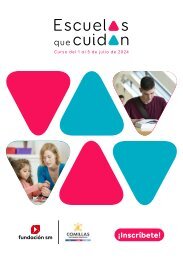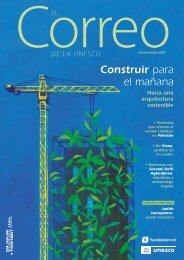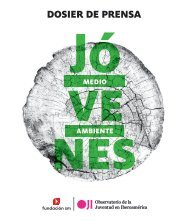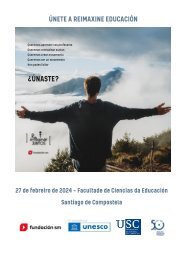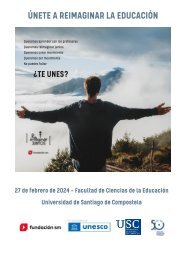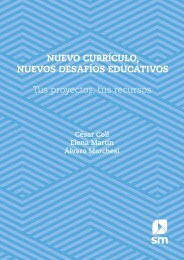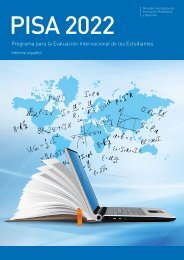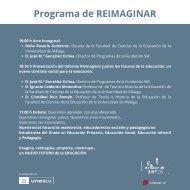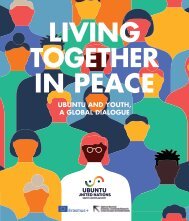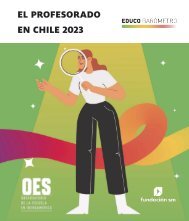Informe PISA 2018 BRASIL (EN)
El Programa para la Evaluación Internacional de Estudiantes (PISA) es una encuesta trienal dirigida a estudiantes de 15 años que evalúa en qué medida han adquirido los conocimientos y habilidades fundamentales para participar plenamente en la sociedad.
El Programa para la Evaluación Internacional de Estudiantes (PISA) es una encuesta trienal dirigida a estudiantes de 15 años que evalúa en qué medida han adquirido los conocimientos y habilidades fundamentales para participar plenamente en la sociedad.
Create successful ePaper yourself
Turn your PDF publications into a flip-book with our unique Google optimized e-Paper software.
The Programme for International Student Assessment (<strong>PISA</strong>) is a triennial survey of 15-year-old students that<br />
assesses the extent to which they have acquired the key knowledge and skills essential for full participation in<br />
society. The assessment focuses on proficiency in reading, mathematics, science and an innovative domain<br />
(in <strong>2018</strong>, the innovative domain was global competence), and on students’ well-being.<br />
Brazil<br />
Key Findings<br />
• In <strong>PISA</strong> <strong>2018</strong>, students in Brazil scored lower than the OECD average in reading, mathematics and<br />
science. Only 2% of students performed at the highest levels of proficiency (Level 5 or 6) in at least<br />
one subject (OECD average: 16%), and 43% of students scored below the minimum level of proficiency<br />
(Level 2) in all three subjects (OECD average: 13%).<br />
• In Brazil, mean mathematics performance improved between 2003 and <strong>2018</strong>, but most of the<br />
improvement occurred in the early cycles of <strong>PISA</strong>. After 2009, in mathematics, as in reading and<br />
science, mean performance did not change significantly.<br />
• Socio-economic status was a strong predictor of performance in reading, mathematics and sciences<br />
in Brazil. Advantaged students outperformed disadvantaged students in reading by 97 score points<br />
(OECD average: 89 score points). In <strong>PISA</strong> 2009, the performance gap in reading related to socioeconomic<br />
status was 84 score points in Brazil (OECD average: 87 score points).<br />
• Some 10% of disadvantaged students in Brazil were able to score in the top quarter of reading<br />
performance (OECD average: 11%), indicating that disadvantage is not destiny.<br />
• In Brazil, low-performing students are clustered in certain schools less often than the OECD average,<br />
and high-performing students more often clustered in certain schools. A disadvantaged student has an<br />
18% chance, on average, of being enrolled in a school with those who score in the top quarter of<br />
reading performance (OECD average: a 17% chance).<br />
• Some 17% of students in Brazil who were enrolled in a disadvantaged school (OECD average: 34%)<br />
and 8% of students enrolled in an advantaged school (OECD average: 18%) attend a school whose<br />
principal reported that the capacity of the school to provide instruction is hindered at least to some<br />
extent by a lack of teaching staff.<br />
• In Brazil, about 1 in 10 high-achieving disadvantaged students – but 1 in 25 high-achieving advantaged<br />
students – does not expect to complete tertiary education.<br />
• Girls outperformed boys in reading by 26 score points (OECD average: 30 score points). By contrast,<br />
boys outperformed girls in mathematics by 9 score points (OECD average: 5 score points). In science,<br />
girls and boys performed similarly in Brazil (OECD average: girls slightly outperformed boys by two<br />
score points).<br />
• Amongst high-performing students in mathematics or science, about one in three boys in Brazil expects<br />
to work as an engineer or science professional at the age of 30, while only one in five girls expects to
2 | Brazil - Country Note - <strong>PISA</strong> <strong>2018</strong> Results<br />
do so. About two in five high-performing girls expect to work in health-related professions, while only<br />
about one in four high-performing boys expects so. Only 4% of boys and almost no girls in Brazil expect<br />
to work in ICT-related professions.<br />
• In Brazil, 29% of students reported being bullied at least a few times a month (OECD average: 23%).<br />
Yet, 85% of students in Brazil agreed or strongly agreed that it is a good thing to help students who<br />
cannot defend themselves (OECD average: 88%).<br />
• Some 41% of students in Brazil reported that, in every or most language-of-instruction lessons, their<br />
teacher has to wait a long time for students to quiet down (OECD average: 26%). In Brazil, students<br />
who reported that, in every or most lessons, the teacher has to wait a long time for students to quiet<br />
down scored 19 score points lower in reading than students who reported that this never happens or<br />
happens only in some lessons, after accounting for socio-economic status.<br />
• In Brazil, 50% of students had skipped a day of school (OECD average: 21%) and 44% of students<br />
had arrived late for school (OECD average: 48%) in the two weeks prior to the <strong>PISA</strong> test.<br />
• Some 48% of students in Brazil reported that their schoolmates co-operate with each other (OECD<br />
average: 62%) and 57% reported that they compete with each other (OECD average: 50%).<br />
• Around 23% of students in Brazil agreed or strongly agreed that they feel lonely at school (OECD<br />
average: 16%).<br />
• In Brazil, 77% of students agreed or strongly agreed that they can usually find a way out of difficult<br />
situations (OECD average: 84%).<br />
What 15-year-old students in Brazil know and can do<br />
Figure 1. Snapshot of performance in reading, mathematics and science<br />
Note: Only countries and economies with available data are shown.<br />
Source: OECD, <strong>PISA</strong> <strong>2018</strong> Database, Tables I.1 and I.10.1.<br />
• Students in Brazil scored lower than the OECD average in reading, mathematics and science.<br />
• Compared to the OECD average, a smaller proportion of students in Brazil performed at the highest<br />
levels of proficiency (Level 5 or 6) in at least one subject; at the same time a smaller proportion of<br />
students achieved a minimum level of proficiency (Level 2 or higher) in at least one subject.<br />
© OECD 2019 Volumes I-III
Brazil - Country Note - <strong>PISA</strong> <strong>2018</strong> Results | 3<br />
What students know and can do in reading<br />
• In Brazil, 50% of students attained at least Level 2 proficiency in reading (OECD average: 77%). At a<br />
minimum, these students can identify the main idea in a text of moderate length, find information based<br />
on explicit, though sometimes complex criteria, and can reflect on the purpose and form of texts when<br />
explicitly directed to do so.<br />
• Some 2% of students in Brazil were top performers in reading, meaning that they attained Level 5 or 6<br />
in the <strong>PISA</strong> reading test (OECD average: 9%). At these levels, students can comprehend lengthy texts,<br />
deal with concepts that are abstract or counterintuitive, and establish distinctions between fact and<br />
opinion, based on implicit cues pertaining to the content or source of the information. In 20 education<br />
systems, including those of 15 OECD countries, more than 10% of 15-year-old students were top<br />
performers.<br />
What students know and can do in mathematics<br />
• Some 32% of students in Brazil attained Level 2 or higher in mathematics (OECD average: 76%). At a<br />
minimum, these students can interpret and recognise, without direct instructions, how a (simple)<br />
situation can be represented mathematically (e.g. comparing the total distance across two alternative<br />
routes, or converting prices into a different currency). The share of 15-year-old students who attained<br />
minimum levels of proficiency in mathematics (Level 2 or higher) varied widely – from 98% in Beijing,<br />
Shanghai, Jiangsu and Zhejiang (China) to 2% in Zambia, which participated in the <strong>PISA</strong> for<br />
Development assessment in 2017. On average across OECD countries, 76% of students attained at<br />
least Level 2 proficiency in mathematics.<br />
• In Brazil, around 1% of students scored at Level 5 or higher in mathematics (OECD average: 11%).<br />
Six Asian countries and economies had the largest shares of students who did so: Beijing, Shanghai,<br />
Jiangsu and Zhejiang (China) (44%), Singapore (37%), Hong Kong (China) (29%), Macao (China)<br />
(28%), Chinese Taipei (23%) and Korea (21%). These students can model complex situations<br />
mathematically, and can select, compare and evaluate appropriate problem-solving strategies for<br />
dealing with them.<br />
What students know and can do in science<br />
• Some 45% of students in Brazil attained Level 2 or higher in science (OECD average: 78%). At a<br />
minimum, these students can recognise the correct explanation for familiar scientific phenomena and<br />
can use such knowledge to identify, in simple cases, whether a conclusion is valid based on the data<br />
provided.<br />
• In Brazil, 1% of students were top performers in science, meaning that they were proficient at<br />
Level 5 or 6 (OECD average: 7%). These students can creatively and autonomously apply their<br />
knowledge of and about science to a wide variety of situations, including unfamiliar ones.<br />
Volumes I-III © OECD 2019
4 | Brazil - Country Note - <strong>PISA</strong> <strong>2018</strong> Results<br />
Performance trends<br />
Figure 2. Trends in performance in reading, mathematics and science<br />
Notes:*indicates mean-performance estimates that are statistically significantly above or below <strong>PISA</strong> <strong>2018</strong> estimates for Brazil.<br />
The blue line indicates the average mean performance across OECD countries with valid data in all <strong>PISA</strong> assessments. The red dotted line indicates<br />
mean performance in Brazil. The black line represents a trend line for Brazil (line of best fit).<br />
Source: OECD, <strong>PISA</strong> <strong>2018</strong> Database, Tables I. B1.10, I. B1.11 and I. B1.12.<br />
• In Brazil, mean performance in mathematics improved over the 2003-18 period, but most of that<br />
improvement was in the early cycles. After 2009, in mathematics, as in reading and science, mean<br />
performance appeared to fluctuate around a flat trend.<br />
• The positive early trends (2000-12) were observed over a period of rapid expansion of secondary<br />
education. Between 2003 and 2012, Brazil added more than 500 000 students to the total population<br />
of 15-year-olds eligible to participate in <strong>PISA</strong>. The proportion of 15-year-olds who were covered by<br />
<strong>PISA</strong> samples increased from about 55% in 2003 to 70% in 2012. It is likely that this expansion in<br />
education opportunities dampened an even more positive underlying trend in student performance.<br />
Indeed, a simulation that assumes that the highest-scoring 25% of 15-year-olds were eligible to take<br />
the test in any given year shows a positive trend amongst this population not only in mathematics<br />
(2003-18), but also in science (2006-18).<br />
© OECD 2019 Volumes I-III
Brazil - Country Note - <strong>PISA</strong> <strong>2018</strong> Results | 5<br />
Where All Students Can Succeed<br />
Figure 3. Differences in performance related to personal characteristics<br />
Notes: Only countries and economies with available data are shown. (1) Girls’ minus boys’ performance; (2) Advantaged minus disadvantaged<br />
students’ performance.<br />
Source: OECD, <strong>PISA</strong> <strong>2018</strong> Database, Tables II.B1.2.3, II.B1.7.1 and II.B1.9.3.<br />
Equity related to socio-economic status<br />
• In Brazil, socio-economically advantaged students outperformed disadvantaged students in reading by<br />
97 score points in <strong>PISA</strong> <strong>2018</strong>. This is not significantly different from the average difference between<br />
the two groups (89 score points) across OECD countries. In <strong>PISA</strong> 2009, the performance gap related<br />
to socio-economic status was 84 score points in Brazil (and 87 score points on average across OECD<br />
countries).<br />
• Some 6% of advantaged students in Brazil, but 0% of disadvantaged students, were top performers in<br />
reading in <strong>PISA</strong> <strong>2018</strong>. On average across OECD countries, 17% of advantaged students, and 3% of<br />
disadvantaged students, were top performers in reading.<br />
• Socio-economic status was a strong predictor of performance in mathematics and science in all <strong>PISA</strong><br />
participating countries. It explained 16% of the variation in mathematics performance in <strong>PISA</strong> <strong>2018</strong> in<br />
Brazil (compared to 14% on average across OECD countries), and 16% of the variation in science<br />
performance (compared to the OECD average of 13% of the variation).<br />
• Some 10% of disadvantaged students in Brazil were able to score in the top quarter of reading<br />
performance within Brazil, indicating that disadvantage is not destiny. On average across OECD<br />
countries, 11% of disadvantaged students scored amongst the highest performers in reading in their<br />
countries.<br />
Volumes I-III © OECD 2019
6 | Brazil - Country Note - <strong>PISA</strong> <strong>2018</strong> Results<br />
Figure 4. School segregation, and gap in material and staff shortage between advantaged and<br />
disadvantaged schools<br />
Notes: Only countries and economies with available data are shown. The isolation indices ranging from 0 (no segregation) to 1 (full segregation)<br />
measure whether low-/high-performing students or disadvantaged students are more or less concentrated in some schools. See detailed description<br />
of the indices in Volume II Chapter 4.<br />
Source: OECD, <strong>PISA</strong> <strong>2018</strong> Database, Tables II.B1.4.1, II.B1.4.8, II.B1.5.13 and II.B1.5.14.<br />
• In Brazil, low-performing students are clustered in certain schools less often than the OECD average,<br />
and high-performing students more often clustered. A disadvantaged student has an 18% chance, on<br />
average, of being enrolled in a school with those who score in the top quarter of reading performance<br />
(OECD average: a 17% chance).<br />
• School principals in Brazil reported less staff shortage and a similar level of material shortage<br />
compared to the OECD average; and school principals of disadvantaged schools more often reported<br />
staff shortage than principals of advantaged schools. In Brazil, 17% of students enrolled in a<br />
disadvantaged school and 8% of students enrolled in an advantaged school attend a school whose<br />
principal reported that the capacity of the school to provide instruction is hindered at least to some<br />
extent by a lack of teaching staff. On average across OECD countries, 34% of students in<br />
disadvantaged schools and 18% of students in advantaged schools attend such a school.<br />
• According to school principals in Brazil, 87% of teachers in advantaged schools and 98% of teachers<br />
in disadvantaged schools are “fully certified”. The proportions of teachers with at least a master’s<br />
degree are larger in advantaged schools than in disadvantaged schools. In Brazil, 18% of teachers in<br />
disadvantaged schools while 15% in advantaged schools have less than five years of professional<br />
experience (the difference is not statistically significant).<br />
• Many students, especially disadvantaged students, hold lower ambitions than would be expected given<br />
their academic achievement. In Brazil, about one in ten high-achieving disadvantaged students – but<br />
1 in 25 high-achieving advantaged students – do not expect to complete tertiary education.<br />
Equity related to gender<br />
• In all countries and economies that participated in <strong>PISA</strong> <strong>2018</strong>, girls significantly outperformed boys in<br />
reading – by 30 score points on average across OECD countries. In Brazil, the gender gap in reading<br />
© OECD 2019 Volumes I-III
Brazil - Country Note - <strong>PISA</strong> <strong>2018</strong> Results | 7<br />
(26 score points) was not significantly different from the average gap. The gap was similar to that<br />
observed in 2009 (29 score points), and both boys’ and girls’ performance remained stable over the<br />
period.<br />
• In Brazil, boys outperformed girls in mathematics by nine score points. Across OECD countries, boys<br />
outperformed girls by five score points. While girls slightly outperformed boys in science (by two score<br />
points) on average across OECD countries in <strong>PISA</strong> <strong>2018</strong>, in Brazil girls and boys performed similarly<br />
in science.<br />
• Amongst high-performing students in mathematics or science, about one in three boys in Brazil expect<br />
to work as an engineer or science professional at the age of 30, while one in five girls expects to do so<br />
(the difference is not statistically significant). About two in five high-performing girls expect to work in<br />
health-related professions, while about one in four high-performing boys expects to do so. Some 4%<br />
of boys and a negligible percentage of girls in Brazil expect to work in ICT-related professions.<br />
Volumes I-III © OECD 2019
8 | Brazil - Country Note - <strong>PISA</strong> <strong>2018</strong> Results<br />
What School Life Means for Students’ Lives<br />
How is the school climate in Brazil?<br />
• In Brazil, 29% of students reported being bullied at least a few times a month, compared to 23% on<br />
average across OECD countries. At the same time, 85% of students in Brazil (and 88% of students on<br />
average across OECD countries) agreed or strongly agreed that it is a good thing to help students who<br />
cannot defend themselves.<br />
• Some 41% of students in Brazil (OECD average: 26%) reported that, in every or most language-ofinstruction<br />
lessons, their teacher has to wait a long time for students to quiet down. In Brazil, students<br />
who reported that, in every or most lessons, the teacher has to wait a long time for students to quiet<br />
down scored 19 score points lower in reading than students who reported that this never happens or<br />
happens only in some lessons, after accounting for socio-economic status.<br />
• On average across OECD countries, 21% of students had skipped a day of school and 48% of students<br />
had arrived late for school in the two weeks prior to the <strong>PISA</strong> test. In Brazil, 50% of students had<br />
skipped a day of school and 44% of students had arrived late for school during that period. In most<br />
countries and economies, frequently bullied students were more likely to have skipped school, whereas<br />
students who valued school, enjoyed a better disciplinary climate and received greater emotional<br />
support from parents were less likely to have skipped school.<br />
Figure 5. School climate<br />
Notes: Only countries and economies with available data are shown. (1) In every or most language-of-instruction lessons; (2) Very or extremely true;<br />
(3) Agreed or strongly agreed.<br />
Source: OECD, <strong>PISA</strong> <strong>2018</strong> Database, Tables III.B1.2.1, III.B1.3.1, III.B1.4.1, III.B1.8.1, III.B1.8.2 and III.B1.9.1<br />
• Some 83% of students in Brazil (OECD average: 74%) agreed or strongly agreed that their teacher<br />
shows enjoyment in teaching. In most countries and economies, including in Brazil, students scored<br />
higher in reading when they perceived their teacher as more enthusiastic, especially when students<br />
said their teachers are interested in the subject.<br />
• In Brazil, 48% of students reported that their schoolmates co-operate with each other (OECD average:<br />
62%) and 57% reported that they compete with each other (OECD average: 50%).<br />
© OECD 2019 Volumes I-III
Brazil - Country Note - <strong>PISA</strong> <strong>2018</strong> Results | 9<br />
• Some 23% of students in Brazil (OECD average: 16%) agreed or strongly agreed that they feel lonely<br />
at school.<br />
How do students in Brazil feel about their lives and learning?<br />
• In Brazil, 65% of students (OECD average: 67%) reported that they are satisfied with their lives<br />
(students who reported between 7 and 10 on the 10-point life-satisfaction scale).<br />
• Some 90% of students in Brazil reported sometimes or always feeling happy and about 13% of<br />
students reported always feeling sad. In most countries and economies, students were more likely to<br />
report positive feelings when they reported a stronger sense of belonging at school and greater student<br />
co-operation, and were more likely to express sadness when they were bullied more frequently.<br />
• In Brazil, 77% of students agreed or strongly agreed that they can usually find a way out of difficult<br />
situations (OECD average: 84%), and 55% agreed or strongly agreed that, when they fail, they worry<br />
about what others think of them (OECD average: 56% of students). In almost every education system,<br />
including Brazil, girls expressed greater fear of failure than boys, and this gender gap was considerably<br />
wider amongst top-performing students.<br />
• A majority of students across OECD countries holds a growth mindset (they disagreed or strongly<br />
disagreed with the statement "Your intelligence is something about you that you can’t change very<br />
much"). In Brazil, 63% of students hold a growth mindset.<br />
Figure 6. Student well-being and growth mindset<br />
Notes: Only countries and economies with available data are shown. (1) Between 7 and 10 on the life-satisfaction scale; (2) Agreed or strongly<br />
agreed; (3) Disagreed or strongly disagreed.<br />
Source: OECD, <strong>PISA</strong> <strong>2018</strong> Database, Tables III.B1.11.1, III.B1.12.1, III.B1.12.2, III.B1.13.1, III.B1.13.2 and III.B1.14.1<br />
Volumes I-III © OECD 2019
10 | Brazil - Country Note - <strong>PISA</strong> <strong>2018</strong> Results<br />
Key features of <strong>PISA</strong> <strong>2018</strong><br />
The content<br />
• The <strong>PISA</strong> <strong>2018</strong> survey focused on reading, with mathematics, science and global competence as<br />
minor areas of assessment; Brazil did not participate in the assessment of global competence.<br />
<strong>PISA</strong> <strong>2018</strong> also included an assessment of young people’s financial literacy, which was optional for<br />
countries and economies. Results for reading, mathematics and science are released on 3 December<br />
2019 and results for global competence and financial literacy in 2020.<br />
The students<br />
• Some 600 000 students completed the assessment in <strong>2018</strong>, representing about 32 million 15-yearolds<br />
in the schools of the 79 participating countries and economies. In Brazil, 10 691 students, in 638<br />
schools, completed the assessment, representing 2 036 861 15-year-old students (65% of the total<br />
population of 15-year-olds).<br />
The assessment<br />
• Computer-based tests were used in most countries, with assessments lasting a total of two hours. In<br />
reading, a multi‐stage adaptive approach was applied in computer -based tests whereby students were<br />
assigned a block of test items based on their performance in preceding blocks.<br />
• Test items were a mixture of multiple-choice questions and questions requiring students to construct<br />
their own responses. The items were organised into groups based on a passage of text describing a<br />
real-life situation. More than 15 hours of test items for reading, mathematics, science and global<br />
competence were covered, with different students taking different combinations of test items.<br />
• Students also answered a background questionnaire, which took about 35 minutes to complete. The<br />
questionnaire sought information about the students themselves, their attitudes, dispositions and<br />
beliefs, their homes, and their school and learning experiences. School principals completed a<br />
questionnaire that covered school management and organisation, and the learning environment.<br />
• Some countries/economies also distributed additional questionnaires to elicit more information. These<br />
included: in 19 countries/economies, a questionnaire for teachers asking about themselves and their<br />
teaching practices; and in 17 countries/economies, a questionnaire for parents asking them to provide<br />
information about their perceptions of and involvement in their child’s school and learning.<br />
• Countries/economies could also chose to distribute three other optional questionnaires for students:<br />
52 countries/economies distributed a questionnaire about students’ familiarity with computers; 32<br />
countries/economies distributed a questionnaire about students’ expectations for further education;<br />
and 9 countries/economies distributed a questionnaire, developed for <strong>PISA</strong> <strong>2018</strong>, about students’ wellbeing.<br />
References<br />
OECD (2019), <strong>PISA</strong> <strong>2018</strong> Results (Volume I): What Students Know and Can Do, <strong>PISA</strong>, OECD Publishing, Paris,<br />
https://doi.org/10.1787/5f07c754-en<br />
OECD (2019), <strong>PISA</strong> <strong>2018</strong> Results (Volume II): Where All Students Can Succeed, <strong>PISA</strong>, OECD Publishing, Paris,<br />
https://doi.org/10.1787/b5fd1b8f-en<br />
OECD (2019), <strong>PISA</strong> <strong>2018</strong> Results (Volume III): What School Life Means for Students’ Lives, <strong>PISA</strong>, OECD Publishing, Paris,<br />
https://doi.org/10.1787/acd78851-en<br />
© OECD 2019 Volumes I-III
Brazil - Country Note - <strong>PISA</strong> <strong>2018</strong> Results | 11<br />
This work is published under the responsibility of the Secretary-General of the OECD. The opinions expressed and arguments<br />
employed herein do not necessarily reflect the official views of OECD member countries.<br />
This document, as well as any data and any map included herein, are without prejudice to the status of or sovereignty over<br />
any territory, to the delimitation of international frontiers and boundaries and to the name of any territory, city or area.<br />
For more information about <strong>PISA</strong> <strong>2018</strong> visit http://www.oecd.org/pisa/<br />
Data can also be found on line by following the<br />
under the tables and charts in the publication.<br />
Explore, compare and visualise more data and analysis using: http://gpseducation.oecd.org/.<br />
Questions can be directed to:<br />
<strong>PISA</strong> team<br />
Directorate for Education and Skills<br />
edu.pisa@oecd.org<br />
Country note authors:<br />
Daniel Salinas, Camila De Moraes and Markus Schwabe<br />
Directorate for Education and Skills<br />
daniel.salinas@oecd.org<br />
Volumes I-III © OECD 2019




